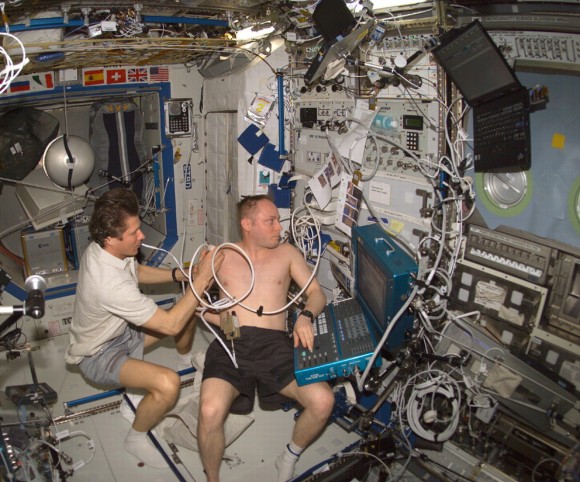

| Visitors Now: | |
| Total Visits: | |
| Total Stories: |

| Story Views | |
| Now: | |
| Last Hour: | |
| Last 24 Hours: | |
| Total: | |
Wrist-Sized Bone Scanner Could Fly To The Space Station In 2016

A full-sized MRI on the International Space Station would take up a lot of size and mass, meaning the astronauts have to use different machines to learn about the body. Here, Russian cosmonaut Gennady Padalka (left) does an ultrasound on NASA astronaut Mike Fincke during Expedition 9 in 2004. Credit: NASA
OTTAWA, CANADA – The University of Saskatchewan hopes to fly a wrist-sized MRI to the International Space Station by 2016 in a standard Progress cargo flight, according to Gordon Sarty, a university professor specializing in medical imaging. Why is this important? It will help doctors keep track of the astronauts’ bone strength on orbit, Sarty says of his team’s invention.
With NASA aiming to run its first one-year mission to the station in 2015, there is renewed emphasis on keeping track of all the nasty things microgravity does to astronauts’ bodies in space. Crew members spend two hours a day exercising, but still come back to Earth having trouble balancing, with weaker bones and muscles, and possible facing changes to organs such as the eyes.
(…)
Read the rest of Wrist-Sized Bone Scanner Could Fly To The Space Station In 2016 (454 words)
© Elizabeth Howell for Universe Today, 2013. |
Permalink |
No comment |
Post tags: bone health, gordon sarty, MRI, neemo 6, space station medicine
Feed enhanced by Better Feed from Ozh
Source: http://www.universetoday.com/106506/wrist-sized-bone-scanner-could-fly-to-the-space-station-in-2016/


